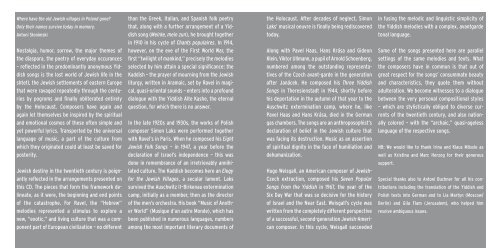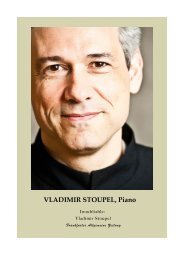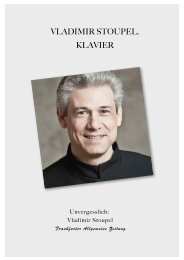elegy for the jewish villages - Vladimir Stoupel
elegy for the jewish villages - Vladimir Stoupel
elegy for the jewish villages - Vladimir Stoupel
Erfolgreiche ePaper selbst erstellen
Machen Sie aus Ihren PDF Publikationen ein blätterbares Flipbook mit unserer einzigartigen Google optimierten e-Paper Software.
Where have <strong>the</strong> old Jewish <strong>villages</strong> in Poland gone?<br />
Only <strong>the</strong>ir names survive today in memory.<br />
Antoni Słonimski<br />
Nostalgia, humor, sorrow, <strong>the</strong> major <strong>the</strong>mes of<br />
<strong>the</strong> diaspora, <strong>the</strong> poetry of everyday occurances<br />
– reflected in <strong>the</strong> predominantly anonymous Yiddish<br />
songs is <strong>the</strong> lost world of Jewish life in <strong>the</strong><br />
shtetl, <strong>the</strong> Jewish settlements of eastern Europe<br />
that were ravaged repeatedly through <strong>the</strong> centuries<br />
by pogroms and finally obliterated entirely<br />
by <strong>the</strong> Holocaust. Composers have again and<br />
again let <strong>the</strong>mselves be inspired by <strong>the</strong> spiritual<br />
and emotional cosmos of <strong>the</strong>se often simple and<br />
yet powerful lyrics. Transported by <strong>the</strong> universal<br />
language of music, a part of <strong>the</strong> culture from<br />
which <strong>the</strong>y originated could at least be saved <strong>for</strong><br />
posterity.<br />
Jewish destiny in <strong>the</strong> twentieth century is poignantly<br />
reflected in <strong>the</strong> arrangements presented on<br />
this CD. The pieces that <strong>for</strong>m <strong>the</strong> framework delineate,<br />
as it were, <strong>the</strong> beginning and end points<br />
of <strong>the</strong> catastrophe. For Ravel, <strong>the</strong> “Hebrew”<br />
melodies represented a stimulus to explore a<br />
new, “exotic,” and living culture that was a component<br />
part of European civilization – no different<br />
than <strong>the</strong> Greek, Italian, and Spanish folk poetry<br />
that, along with a fur<strong>the</strong>r arrangement of a Yiddish<br />
song (Meirke, mein zun), he brought toge<strong>the</strong>r<br />
in 1910 in his cycle of Chants populaires. In 1914,<br />
however, on <strong>the</strong> eve of <strong>the</strong> First World War, <strong>the</strong><br />
first “twilight of mankind,” precisely <strong>the</strong> melodies<br />
selected by him attain a special significance: <strong>the</strong><br />
Kaddish – <strong>the</strong> prayer of mourning from <strong>the</strong> Jewish<br />
liturgy, written in Aramaic, set by Ravel in magical,<br />
quasi-oriental sounds – enters into a profound<br />
dialogue with <strong>the</strong> Yiddish Alte Kashe, <strong>the</strong> eternal<br />
question, <strong>for</strong> which <strong>the</strong>re is no answer.<br />
In <strong>the</strong> late 1920s and 1930s, <strong>the</strong> works of Polish<br />
composer Simon Laks were per<strong>for</strong>med toge<strong>the</strong>r<br />
with Ravel’s in Paris. When he composed his Eight<br />
Jewish Folk Songs – in 1947, a year be<strong>for</strong>e <strong>the</strong><br />
declaration of Israel’s independence – this was<br />
done in remembrance of an irretrievably annihilated<br />
culture. The Kaddish becomes here an Elegy<br />
<strong>for</strong> <strong>the</strong> Jewish Villages, a secular lament. Laks<br />
survived <strong>the</strong> Auschwitz II–Birkenau extermination<br />
camp, initially as a member, <strong>the</strong>n as <strong>the</strong> director<br />
of <strong>the</strong> men’s orchestra. His book “Music of Ano<strong>the</strong>r<br />
World” (Musique d’un autre Monde), which has<br />
been published in numerous languages, numbers<br />
among <strong>the</strong> most important literary documents of<br />
<strong>the</strong> Holocaust. After decades of neglect, Simon<br />
Laks’ musical oeuvre is finally being rediscovered<br />
today.<br />
Along with Pavel Haas, Hans Krása and Gideon<br />
Klein, Viktor Ullmann, a pupil of Arnold Schoenberg,<br />
numbered among <strong>the</strong> outstanding representatives<br />
of <strong>the</strong> Czech avant-garde in <strong>the</strong> generation<br />
after Janácek. He composed his Three Yiddish<br />
Songs in Theresienstadt in 1944, shortly be<strong>for</strong>e<br />
his deportation in <strong>the</strong> autumn of that year to <strong>the</strong><br />
Auschwitz extermination camp, where he, like<br />
Pavel Haas and Hans Krása, died in <strong>the</strong> German<br />
gas chambers. The songs are an anthroposophist’s<br />
declaration of belief in <strong>the</strong> Jewish culture that<br />
was facing its destruction. Music as an assertion<br />
of spiritual dignity in <strong>the</strong> face of humiliation and<br />
dehumanization.<br />
Hugo Weisgall, an American composer of Jewish-<br />
Czech extraction, composed his Seven Popular<br />
Songs from <strong>the</strong> Yiddish in 1967, <strong>the</strong> year of <strong>the</strong><br />
Six Day War that was so decisive <strong>for</strong> <strong>the</strong> history<br />
of Israel and <strong>the</strong> Near East. Weisgall’s cycle was<br />
written from <strong>the</strong> completely different perspective<br />
of a successful, second-generation Jewish-American<br />
composer. In this cycle, Weisgall succeeded<br />
in fusing <strong>the</strong> melodic and linguistic simplicity of<br />
<strong>the</strong> Yiddish melodies with a complex, avantgarde<br />
tonal language.<br />
Some of <strong>the</strong> songs presented here are parallel<br />
settings of <strong>the</strong> same melodies and texts. What<br />
<strong>the</strong> composers have in common is that out of<br />
great respect <strong>for</strong> <strong>the</strong> songs’ consummate beauty<br />
and characteristics, <strong>the</strong>y quote <strong>the</strong>m without<br />
adulteration. We become witnesses to a dialogue<br />
between <strong>the</strong> very personal compositional styles<br />
– which are stylistically obliged to diverse currents<br />
of <strong>the</strong> twentieth century, and also nationally<br />
colored – with <strong>the</strong> “archaic,” quasi-ageless<br />
language of <strong>the</strong> respective songs.<br />
NB: We would like to thank Irina and Klaus Mössle as<br />
well as Kristina and Marc Herzog <strong>for</strong> <strong>the</strong>ir generous<br />
2 3<br />
support.<br />
Special thanks also to Antoni Buchner <strong>for</strong> all his con-<br />
tributions including <strong>the</strong> translation of <strong>the</strong> Yiddish and<br />
Polish texts into German and to Lia Martyn (Moscow/<br />
Berlin) and Gila Flam (Jerusalem), who helped him<br />
resolve ambiguous issues.





